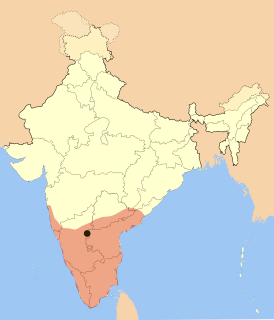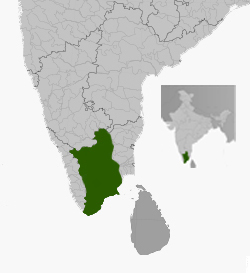
The Vijayanagara Empire, also called Karnata Kingdom, was based in the Deccan Plateau region in South India. It was established in 1336 by the brothers Harihara I and Bukka Raya I of the Sangama dynasty, members of a pastoralist cowherd community that claimed Yadava lineage. The empire rose to prominence as a culmination of attempts by the southern powers to ward off Islamic invasions by the end of the 13th century. At its peak, it subjugated almost all of South India's ruling families and pushed the sultans of the Deccan beyond the Tungabhadra-Krishna river doab region, in addition to annexing modern day Odisha from the Gajapati Kingdom thus becoming a notable power. It lasted until 1646, although its power declined after a major military defeat in the Battle of Talikota in 1565 by the combined armies of the Deccan sultanates. The empire is named after its capital city of Vijayanagara, whose ruins surround present day Hampi, now a World Heritage Site in Karnataka, India. The wealth and fame of the empire inspired visits by and writings of medieval European travelers such as Domingo Paes, Fernão Nunes, and Niccolò de' Conti. These travelogues, contemporary literature and epigraphy in the local languages and modern archeological excavations at Vijayanagara has provided ample information about the history and power of the empire.

The history of southern India covers a span of over four thousand years during which the region saw the rise and fall of a number of dynasties and empires. The period of known history of the region begins with the Iron Age period until the 15th century CE. Dynasties of Chera, Chola, Pandyan, Chalukya, Pallava, Satavahana Rashtrakuta, Kakatiya, Reddy dynasty, Seuna (Yadava) dynasty and Hoysala were at their peak during various periods of history. These Dynasties constantly fought amongst each other and against external forces when northern armies invaded southern India. Vijayanagara empire rose in response to the Muslim intervention and covered the most of southern India and acted as a bulwark against Mughal expansion into the south. When the European powers arrived during the 16th and 18th century CE, the southern kingdoms, most notably Tipu Sultan's Kingdom of Mysore, resisted the new threats, and many parts eventually succumbed to British occupation. The British created the Madras Presidency which acted as an administrative centre for the rest of South India, with them being princely states. After Indian independence South India was linguistically divided into the states of Andhra Pradesh, Tamil Nadu, Karnataka, Telangana and Kerala.

Krishnadevaraya was an emperor, of the Vijayanagara Empire, who reigned from 1509–1529. He was the third ruler of the Tuluva Dynasty and is considered to be its greatest ruler. He possessed the largest empire in India after the decline of the Delhi Sultanate. Presiding over the empire at its zenith, he is regarded as an icon by many Indians. Krishnadevaraya earned the titles Kannada Rajya Rama Ramana, Andhra Bhoja, Gaubrahmana Pratipalaka and Mooru Rayara Ganda. He became the dominant ruler of the peninsula of India by defeating the Sultans of Bijapur, Golconda, the Bahmani Sultanate and the Gajapatis of Odisha, and was one of the most powerful Hindu rulers in India. Indeed, when the Mughal Emperor Babur was taking stock of the potentates of north India, Krishnadevaraya was rated the most powerful and had the most extensive empire in the subcontinent.
Reddy is a caste that originated in India, predominantly settled in Andhra Pradesh and Telangana. They are classified as a forward caste.

The Reddy Kingdom or Kondavidu Reddy Kingdom was established in southern India by Prolaya Vema Reddy. The region that was ruled by the Reddy dynasty is now part of modern-day coastal and central Andhra Pradesh. Prolaya Vema Reddy was part of the confederation that started a movement against the invading Turkic armies of the Delhi Sultanate in 1325 and succeeded in repulsing them from Warangal.

Bammera Pothana (1450–1510) was a Telugu poet best known for his translation of the Bhagavata Purana from Sanskrit to Telugu. He was a Telugu and Sanskrit Scholar. His work, Sri Andhra Maha Bhagavatamu, is popularly called as Pothana Bhagavatam in Telugu.

Deva Raya II was an emperor of the Vijayanagara Empire. The greatest of the Sangama dynasty rulers, he was an able administrator, warrior, and scholar. He authored well-known works in the Kannada language and in the Sanskrit language. He was patron to some of the most noted Kannada poets of the medieval period, including Chamarasa and Kumara Vyasa, the Sanskrit poet Gunda Dimdima, and the noted Telugu language poet Srinatha, whom the king honored with the title Kavisarvabhauma. He supported development in secular literature as well as the noted South Indian mathematician Parameshvara, from the Kerala school of astronomy and mathematics lived in his empire.

The Musunuri Nayakas were warrior kings of 14th-century South India who were briefly significant in the region of Telangana and Andhra Pradesh. Musunuri Kapaya Nayaka is said to have taken a leadership role among the Andhra chieftains and driven out the Delhi Sultanate from Warangal. But his rise was soon challenged by the Bahmani Sultanate and he was defeated. The Recherla Nayakas wrested power from him in 1368.
Historians have deciphered writings on the walls of temples describing the names and gotras of some Telugu rulers and the contributions made by them to the temples and towns.
Pemmasani Nayaks were a ruling clan in the south Indian state of Andhra Pradesh. They came into prominence during Vijayanagara times as rulers of Gandikota over 300 years. After the Battle of Talikota in 1565 AD, the collapse of Vijayanagara Empire led to the emergence of Pemmasani Nayakas in the Rayalaseema region. They belonged to the Kamma social group.
Tuluva Narasa Nayaka was the founder of the Tuluva dynasty of the Vijayanagara Empire. He was the father of emperor Krishnadevaraya.

The Gajapati Empire was a Royal dynasty established by the Suryavamsa or Routray dynasty, who were a medieval Hindu dynasty from the Indian subcontinent, which originated in the region of Odradesha from 1434 to 1541 CE. Under Kapilendra Deva, Gajapatis became an empire stretching from the lower Ganga in the north to the Kaveri in the south.

The Madurai Nayaks were rulers of Telugu origin from around 1529 until 1736, of a region comprising most of modern-day Tamil Nadu, India, with Madurai as their capital. The Nayak reign was an era noted for its achievement in arts, cultural and administrative reforms, revitalization of temples previously ransacked by the Delhi Sultans, and inauguration of a unique architectural style.

Panagal, also referred to as Panagallu or Panugallu, is a historic town located 4 km northeast from Nalgonda city in Telangana, India.

Andhra Pradesh is one of the 28 states of India, whose recorded history begins in the Vedic period. It is mentioned in Sanskrit epics such as Aitareya Brahmana. The Assaka Mahajanapada was an ancient kingdom located between the Godavari and Krishna Rivers in southeastern India.
Shitab Khan, also spelled Chitapu Khan, was born Sitapathi Raju in the Telangana, India. He joined as a foot soldier in the army of Humayun Shah the Bahmani Sultan, and rose up the ranks to acquire senior captaincy, his own jagir and the title 'Shitab Khan'. He always used the title in his inscriptions but never actually converted to Islam.

Kapilendra Deva was the founder of the Suryavamsa Gajapati Empire that ruled parts of eastern and southern India, including present-day Odisha as the center of his empire. He had staged a military coup against the preceding and the last Eastern Ganga dynasty ruler Bhanu Deva IV and overtook the throne as the king was weak and had lost territories to the south. His name is also written as Kapilendra Routray or Sri Sri Kapilendra Deva. In claiming descent from the Surya Vamsha of the Mahabharata, he also took the title shri shri ...(108 times) Gajapati Gaudeshwara NabaKoti Karnata Kalabargeswara. This title literally meant the lord of Bengal (Gauda), of Karnataka region or Vijayanagara, the lord of Gulbarga and of nine crore subjects.

Warangal Fort is located in Warangal District, Telangana, India. It was the capital city of Kakatiya dynasty and Musunuri Nayakas. It appears to have existed since at least the 12th century when it was the capital of the Kakatiyas. The fort has four ornamental gates, known as Kakatiya Kala Thoranam, that originally formed the entrances to a now ruined great Shiva temple. The Kakatiyan arch has been adopted and officially incorporated into the emblem of Telangana after the bifurcation of Andhra Pradesh. The fort is included in the "tentative list" of UNESCO World Heritage Site and was submitted by the Permanent Delegation of India to UNESCO on 10/09/2010.

Recherla Nayakas were an Andhra dynasty that wrested power from the Musunuri Nayakas and became the dominant power in the Telangana region during the late 14th century and early 15th century. They were based at Rachakonda, southeast of Golconda, the border with the Bahmani sultanate during this period, and built a second base at Devarakonda.

Vira Pratapa Purushottama Deva was the second Gajapati emperor of Odisha who ruled from 1467 to 1497 C.E. He was the second ruler from the Suryavamsa Gajapati Empire. His father Gajapati Kapilendra Deva Routaraya chose him as his heir to rule Odishan Empire at the banks of river Krishna where he breathed his last. This decision infuriated the elder brother Hamvira Deva who was a battle hardened and successful warrior fulfilling the task of conquering the southern territories and expeditions against the kingdom of Vijayanagara as wished by his father.














